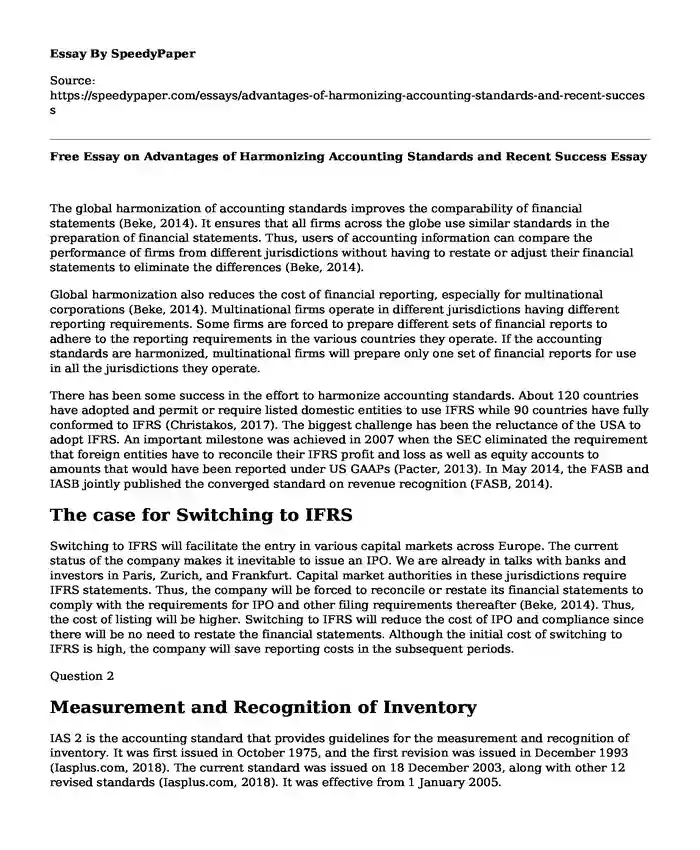
| Type of paper: | Essay |
| Categories: | Accounting |
| Pages: | 3 |
| Wordcount: | 808 words |
The global harmonization of accounting standards improves the comparability of financial statements (Beke, 2014). It ensures that all firms across the globe use similar standards in the preparation of financial statements. Thus, users of accounting information can compare the performance of firms from different jurisdictions without having to restate or adjust their financial statements to eliminate the differences (Beke, 2014).
Global harmonization also reduces the cost of financial reporting, especially for multinational corporations (Beke, 2014). Multinational firms operate in different jurisdictions having different reporting requirements. Some firms are forced to prepare different sets of financial reports to adhere to the reporting requirements in the various countries they operate. If the accounting standards are harmonized, multinational firms will prepare only one set of financial reports for use in all the jurisdictions they operate.
There has been some success in the effort to harmonize accounting standards. About 120 countries have adopted and permit or require listed domestic entities to use IFRS while 90 countries have fully conformed to IFRS (Christakos, 2017). The biggest challenge has been the reluctance of the USA to adopt IFRS. An important milestone was achieved in 2007 when the SEC eliminated the requirement that foreign entities have to reconcile their IFRS profit and loss as well as equity accounts to amounts that would have been reported under US GAAPs (Pacter, 2013). In May 2014, the FASB and IASB jointly published the converged standard on revenue recognition (FASB, 2014).
The case for Switching to IFRS
Switching to IFRS will facilitate the entry in various capital markets across Europe. The current status of the company makes it inevitable to issue an IPO. We are already in talks with banks and investors in Paris, Zurich, and Frankfurt. Capital market authorities in these jurisdictions require IFRS statements. Thus, the company will be forced to reconcile or restate its financial statements to comply with the requirements for IPO and other filing requirements thereafter (Beke, 2014). Thus, the cost of listing will be higher. Switching to IFRS will reduce the cost of IPO and compliance since there will be no need to restate the financial statements. Although the initial cost of switching to IFRS is high, the company will save reporting costs in the subsequent periods.
Question 2
Measurement and Recognition of Inventory
IAS 2 is the accounting standard that provides guidelines for the measurement and recognition of inventory. It was first issued in October 1975, and the first revision was issued in December 1993 (Iasplus.com, 2018). The current standard was issued on 18 December 2003, along with other 12 revised standards (Iasplus.com, 2018). It was effective from 1 January 2005.
The objective of IAS 2 is to provide guidance on the accounting for inventory. This includes guidelines for the determination of the cost of inventory as well as the recognition of an expense (Iasplus.com, 2018). It prescribes the methods and formulas for determining the cost of inventory.
Cost Methods and Formulas
IAS 2 provides that inventory must be reported at the lower of cost and net realizable value. It provides that the cost of inventory items that are interchangeable can be determined using FIFO or weighted average cost methods (Iasplus.com, 2018). The revised standard outlaws explicitly the use of LIFO. It further states that the cost of inventory includes the cost of purchase conversion costs and any other costs incurred to bring it to the current condition or location (Iasplus.com, 2018).
The standard also indicates that the net realizable value of inventory is the difference between the expected selling price and the costs necessary to sell the inventory (Iasplus.com, 2018). When the cost is less than NRV, the inventory must be written down, and the write-down is recognized as an expense.
"Too much Inventory" Case
BB Ltd was struggling to sell its Blackberry handsets and had a large balance of unsold units at the end of the financial period. Due to increased competition, it was impossible for the company to sell the handsets at the values indicated on the balance sheet. This implies that the net realizable value was less than the cost of inventory. IAS 2 mandates BB Ltd to report the inventory at the value that is lower between NRV and cost. In this case, BB Ltd had to write-down report the inventory at NRV. IAS 2 further mandates that when inventory is reported at NRV, the write-down is recognized as an expense.
Journal Entry for Write-downs
Dr. Write-down to NRV $2.4 billion
Inventory $2.4 billion
References
Beke, J. (2014). International accounting standardization. Oxford: Chartridge Books Oxford.
Christakos, P. (2017). Convergence of Global Accounting Standards. Retrieved from http://www.njcpa.org/stay-informed/topics/article/2017/08/09/convergence-of-global-accounting-standards
FASB. (2014). IASB AND FASB ISSUE CONVERGED STANDARD ON REVENUE RECOGNITION. Retrieved from https://www.fasb.org/jsp/FASB/FASBContent_C/NewsPage&cid=1176164075286&pf=true
Iasplus.com. (2018). IAS 2 - Inventories. Retrieved from https://www.iasplus.com/en/standards/ias/ias2
Pacter, P. (2013). What have IASB and FASB convergence efforts achieved?. Retrieved from https://www.journalofaccountancy.com/issues/2013/feb/20126984.html
Cite this page
Free Essay on Advantages of Harmonizing Accounting Standards and Recent Success. (2022, Sep 15). Retrieved from https://speedypaper.com/essays/advantages-of-harmonizing-accounting-standards-and-recent-success
Request Removal
If you are the original author of this essay and no longer wish to have it published on the SpeedyPaper website, please click below to request its removal:
- Free Essay Sample on Basketball on Paper by Dean Oliver
- Capital Budgeting Essay Sample for Free
- Free Essay on Women Empowerment in The Yellow Wallpaper
- Free Essay on Whether Flexible Working Hours Foster Teamwork
- Essay Sample on Immigration to the United States
- Essay Sample Describing the Puerto Rico Holiday
- Free Essay Example: Fatigue, Hair falling out.
Popular categories




